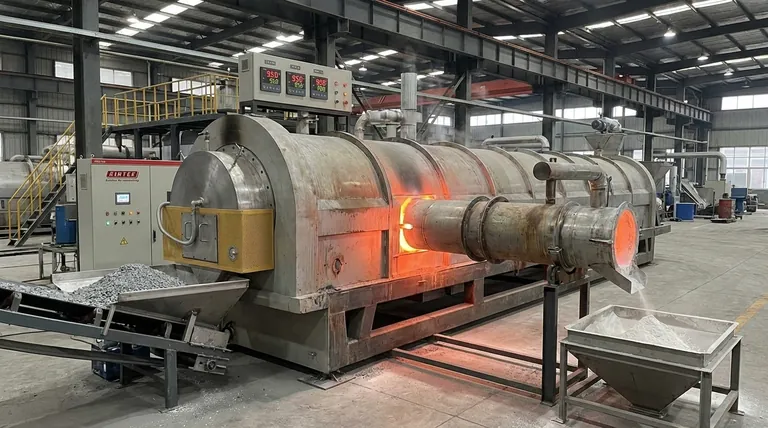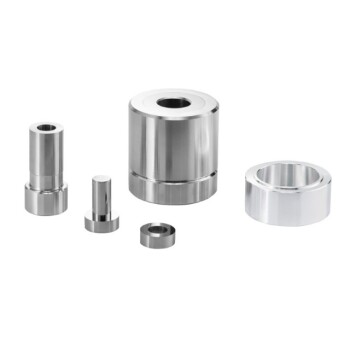The operating temperature of a calciner is not a single value but a wide range, typically between 550°C and 1300°C (1000°F to 2372°F). The precise temperature is dictated entirely by the material being processed and the specific chemical or physical transformation required. This adaptability is what makes calcination a critical industrial process.
A calciner's temperature isn't a fixed setting but a critical process variable. The correct temperature is determined by the target material's decomposition point and the specific phase change or purification required, making the process highly adaptable rather than one-size-fits-all.

The Purpose of High-Temperature Processing
Calcination is a thermal treatment process designed to induce change in a material. The equipment, a calciner, is essentially a rotating steel cylinder inside a furnace that allows for precise control over this transformation.
The Goal is Transformation, Not Melting
The fundamental purpose of applying such high heat is to cause a thermal decomposition. This process breaks down the material and drives off volatile substances without actually melting it.
Common volatiles removed during calcination include chemically bound water (hydrates) and carbon dioxide (carbonates). This purifies the material or prepares it for a subsequent process.
Indirect Heat is Crucial for Purity
Calciners use indirect heating. The material inside the rotating cylinder is heated through the steel wall, but it never comes into direct contact with the furnace flames or combustion gases.
This separation ensures the material remains pure and that its reaction is not influenced by outside contaminants. It also allows for precise control over the atmosphere within the cylinder, preventing unwanted reactions like oxidation.
Why Such a Wide Temperature Range?
The significant variance in operating temperatures stems from the unique chemical properties of each material being processed. Different compounds decompose at different temperatures.
Material-Specific Decomposition Points
Every material has a specific temperature at which it will decompose. For example, the calcination of limestone (calcium carbonate) to produce lime (calcium oxide) requires temperatures around 900°C to effectively drive off the carbon dioxide.
In contrast, dehydrating a mineral like gypsum to produce plaster of Paris occurs at much lower temperatures, often below 200°C. Processing advanced ceramics or certain ores may require the upper end of the range, exceeding 1100°C.
The Target Transformation Dictates the Heat
The required temperature is linked directly to the strength of the chemical bonds being broken. Driving off loosely bound water requires less energy (and thus a lower temperature) than breaking down a stable carbonate structure.
In some applications, the goal isn't chemical decomposition but a physical change, such as altering the crystalline structure of a material to improve its properties. These phase transitions are also highly temperature-dependent.
Key Operational Considerations
Simply setting a temperature is not enough. The process requires a careful balance to achieve the desired outcome efficiently and safely, avoiding common pitfalls.
The Risk of Over-heating
Exceeding the optimal temperature can be just as detrimental as not reaching it. Over-heating, or "dead burning," can cause sintering, where the material particles begin to fuse.
This can drastically reduce the reactivity of the final product, making it unsuitable for its intended use. In extreme cases, it can lead to melting and damage to the equipment.
The Inefficiency of Under-heating
Failing to reach the required decomposition temperature results in an incomplete reaction. The final product will remain contaminated with the original compound, failing to meet quality specifications.
This requires reprocessing the material, which wastes significant time, energy, and resources, making precise temperature control a critical factor in operational efficiency.
Matching the Temperature to Your Goal
To determine the correct operating temperature, you must first define the material and the desired outcome.
- If your primary focus is producing lime from limestone: You will operate in the 900°C to 1000°C range to ensure complete CO2 removal without causing sintering.
- If your primary focus is dehydrating industrial minerals: A lower temperature, typically between 300°C and 600°C, is sufficient to remove chemically bound water.
- If your primary focus is synthesizing advanced materials or pigments: You will likely require the upper end of the range, often exceeding 1100°C, to achieve specific crystalline structures and properties.
Ultimately, a calciner's operating temperature is a precise tool used to unlock the desired properties locked within a material.
Summary Table:
| Material / Process Goal | Typical Operating Temperature Range | Key Transformation |
|---|---|---|
| Lime Production (Limestone) | 900°C - 1000°C | Decomposition of CaCO₃ to CaO + CO₂ |
| Dehydration of Minerals (e.g., Gypsum) | < 200°C - 600°C | Removal of chemically bound water |
| Advanced Ceramics / Pigments | > 1100°C - 1300°C | Synthesis of specific crystalline structures |
| General Industrial Calcination | 550°C - 1300°C | Thermal decomposition or phase change |
Ready to Optimize Your Calcination Process?
Determining the precise operating temperature is critical for your product's quality and process efficiency. The wrong temperature can lead to incomplete reactions, sintering, or wasted resources.
KINTEK is your trusted partner for all your calcination needs. We specialize in providing high-quality lab equipment and consumables, serving laboratories and industrial facilities that rely on precise thermal processing.
We can help you:
- Select the right calcination equipment for your specific temperature and material requirements.
- Achieve precise temperature control to ensure complete reactions and avoid costly errors like dead-burning.
- Enhance your lab's capabilities with reliable equipment designed for consistent, high-purity results.
Don't leave your thermal processing to chance. Contact our experts today to discuss how we can support your laboratory's success.
Visual Guide

Related Products
- Electric Rotary Kiln Continuous Working Small Rotary Furnace Heating Pyrolysis Plant
- Three-dimensional electromagnetic sieving instrument
- Laboratory Single Horizontal Jar Mill
- Laboratory Disc Rotary Mixer for Efficient Sample Mixing and Homogenization
- Laboratory Test Sieves and Sieving Machines
People Also Ask
- What is the meaning of rotary furnace? Achieve Superior Uniformity in Continuous Heat Treatment
- What are the equipment for pyrolysis laboratory? Choosing the Right Reactor for Your Research
- How does a rotary extractor work? Master Continuous High-Volume Solid Processing
- What are the zones in rotary kiln in cement production? Master the Core Process for High-Quality Clinker
- What is the drying zone in a rotary kiln? Boost Efficiency with Modern Drying Solutions



















